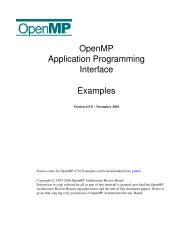D2 3 Computing e-Infrastructure cost calculations and business _models_vam1-final
D2 3 Computing e-Infrastructure cost calculations and business _models_vam1-final
D2 3 Computing e-Infrastructure cost calculations and business _models_vam1-final
You also want an ePaper? Increase the reach of your titles
YUMPU automatically turns print PDFs into web optimized ePapers that Google loves.
e-‐FISCAL: www.efiscal.eu <br />
EC Contract Number: 283449 <br />
The pricing of cloud services is also another issue. The e-‐Science Institute 23 focuses on the steady decrease in <br />
prices offered by Amazon for their services. They comment that over time, the price to rent one unit of resources <br />
for three years of continuous usage has fallen dramatically as Amazon offered new instance types, offered new <br />
long-‐term pricing plans, <strong>and</strong> lowered prices outright across the board. <br />
2.4 Business <strong>models</strong><br />
IT is an ever-‐evolving l<strong>and</strong>scape; today countless innovative <strong>business</strong> <strong>models</strong> are emerging as well as other <br />
entirely new industries forming <strong>business</strong> <strong>models</strong> around cloud computing, social media <strong>and</strong> smart devices. This <br />
growing trend is now spilling over into the public sector as well. Funding agencies across Europe are looking to <br />
focus investments on more targeted areas that will stimulate innovation <strong>and</strong> economic growth. <br />
Defining <strong>business</strong> <strong>models</strong> help provide the necessary structure for organizations to develop a series of <br />
organisational <strong>and</strong> strategic components for delivering its value to its consumers. However, a common <br />
misconception in the public sector is that a <strong>business</strong> model is how to generate revenue or conduct commercial <br />
activities. While any organisation that creates <strong>and</strong> delivers value must be able to generate enough revenue to <br />
cover its expenses, a <strong>business</strong> model is much more than that. It can be basic or complex, but is simply “the <br />
rationale or description of how an organisation creates, delivers, <strong>and</strong> captures value”. Osterwalder (2010) 24<br />
developed a simple one-‐page template to discuss the key elements on <strong>business</strong> <strong>models</strong>, <strong>and</strong> <strong>cost</strong> <strong>and</strong> revenue <br />
streams are two important elements. <br />
In the following sub-‐sections the state of the art in <strong>business</strong> <strong>models</strong> for publicly-‐funded federated e-‐<br />
<strong>Infrastructure</strong>s is reviewed, along with some basic trends in the <strong>business</strong> <strong>and</strong> pricing modes of cloud computing. <br />
2.5 Federated <strong>Infrastructure</strong>s <strong>and</strong> Business Models<br />
Publicly funded e-‐<strong>Infrastructure</strong>s are inherently different in nature both in terms of funding structure <strong>and</strong> <br />
purpose. The main focus of e-‐<strong>Infrastructure</strong>s is to support <strong>and</strong> facilitate world-‐class research. The e-‐<br />
<strong>Infrastructure</strong>s themselves have been built, maintained <strong>and</strong> operated through public financing, which comes with <br />
certain restrictions on what can <strong>and</strong> cannot be done with the resources (e.g. selling computing capacity, running <br />
commercial applications). <br />
Therefore, the application of <strong>business</strong> <strong>models</strong> drastically changes in the public sector from that in the commercial <br />
world. e-‐<strong>Infrastructure</strong>s in Europe operate within a publicly funded research <strong>and</strong> academic environment providing <br />
services free at point of delivery with resources bought from grants dedicated to certain groups or disciplines <br />
either by direct allocation or by peer review. With the advent of cloud computing, <strong>business</strong> <strong>models</strong> <strong>and</strong> user <br />
expectations are shifting towards on-‐dem<strong>and</strong> provision increasing flexibility <strong>and</strong> agility. In a distributed <br />
environment, services are provided by a variety of different organizations spread across Europe <strong>and</strong> beyond. <br />
23 http://escience.washington.edu/blog/cloud-‐economics-‐visualizing-‐aws-‐prices-‐over-‐time <br />
24 A. Osterwalder “Business Model Generation”, Wiley 2010 <br />
e-‐FISCAL : Financial Study for Sustainable <strong>Computing</strong> e-‐<strong>Infrastructure</strong>s <br />
Deliverable <strong>D2</strong>.3 – <strong>Computing</strong> e-‐<strong>Infrastructure</strong>s <strong>cost</strong> estimation <strong>and</strong> analysis – Pricing <strong>and</strong> <br />
Business <strong>models</strong> <br />
27




